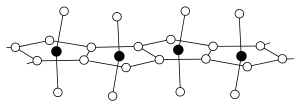
| |
| Names | |
|---|---|
| IUPAC name
Protactinium(V) chloride
| |
| Other names
Protactinium pentachloride, Protactinium chloride
| |
| Identifiers | |
3D model (JSmol)
|
|
| ChemSpider | |
PubChem CID
|
|
| |
| |
| Properties | |
| PaCl5 | |
| Molar mass | 408.301 g/mol |
| Appearance | yellow monoclinic crystals[1] |
| Density | 3.74 g/cm3[1] |
| Melting point | 306 °C (583 °F; 579 K)[1] |
| Boiling point | 420 °C (788 °F; 693 K)[2] |
| Structure | |
| monoclinic, mS24 | |
| c12/c1, #15 | |
| Pa, 7, pentagonal bipyramidal Cl, 1 and 2 | |
| Related compounds | |
Other anions
|
Protactinium(V) fluoride Protactinium(V) bromide Protactinium(V) iodide |
Other cations
|
Praseodymium(III) chloride Uranium(IV) chloride Thorium(IV) chloride |
Related compounds
|
Protactinium(IV) chloride |
Except where otherwise noted, data are given for materials in their standard state (at 25 °C [77 °F], 100 kPa).
| |
Protactinium(V) chloride is the chemical compound composed of protactinium and chlorine with the formula PaCl5. It forms yellow monoclinic crystals and has a unique structure composed of chains of 7 coordinate, pentagonal bipyramidal, protactinium atoms sharing edges.[3]
Protactinium(V) chloride can react with boron tribromide at high temperatures to form protactinium(V) bromide.[4] It also reacts with fluorine to form protactinium(V) fluoride at high temperatures.[4]
See also
References
- ^ a b c Lide, David R. (1998). Handbook of Chemistry and Physics (87 ed.). Boca Raton, FL: CRC Press. p. 484. ISBN 0849305942. Retrieved 2008-07-17.
- ^ "Chemistry: WebElements Periodic Table: Professional Edition: Protactinium: compound data (protactinium (V) chloride)". WebElements. Retrieved 2008-07-17.[permanent dead link]
- ^ R. P. Dodge, G. S. Smith, Q. Johnson, R. E. Elson: „The Crystal Structure of Protactinium Pentachloride“, Acta Crystallogr., 1967, 22, 85–89; doi:10.1107/S0365110X67000155.
- ^ a b Georg Brauer (Hrsg.), unter Mitarbeit von Marianne Baudler u. a.: Handbuch der Präparativen Anorganischen Chemie. 3., umgearbeitete Auflage. Band I, Ferdinand Enke, Stuttgart 1975, ISBN 3-432-02328-6, S. 1177.
